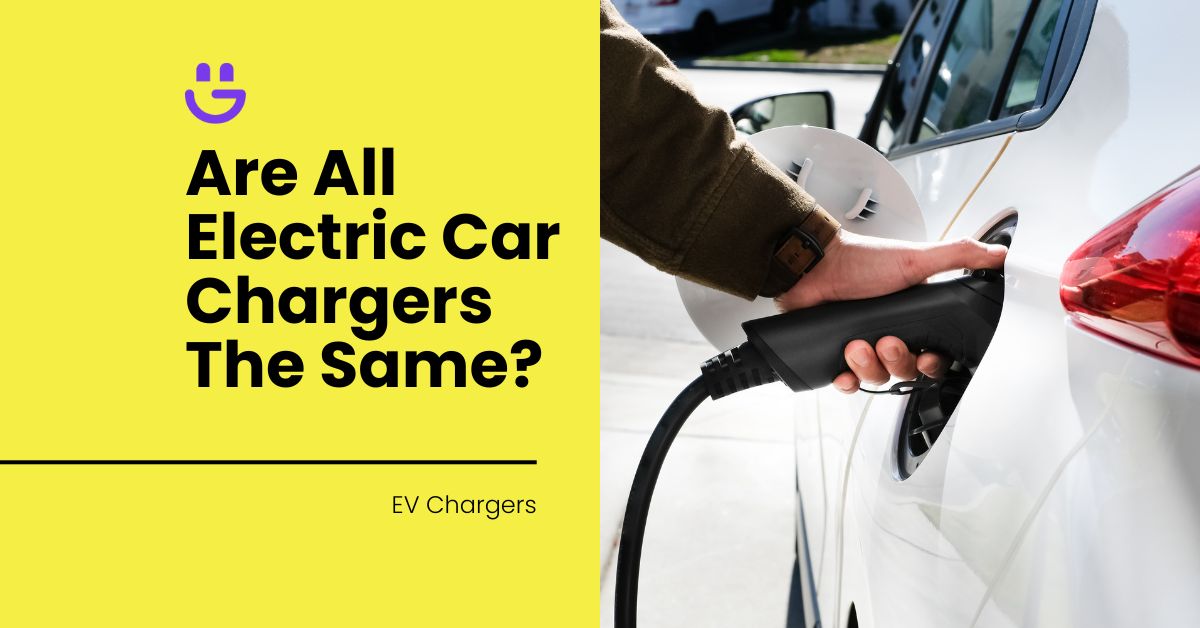Last Updated on October 10, 2024
Contents
Are All Electric Car Chargers The Same?
Are electric car (EV) chargers universal? No, electric cars use different chargers. The EV charger market is large and competitive with ongoing innovation. Even many long-time electric vehicle owners don’t fully understand the different EV charger systems, not to mention the terminology.
Fortunately, Eco Happy is here to break down the difference between Mode 4 and Type 2, Tesla Superchargers and DC fast charging, and much more. If you’re strapped in for an electric car future, read on to learn more about the main EV charger types, speeds, and components, and the role of home and public chargers.
Charger Speeds And Locations
Speed is a crucial element that differentiates electric car charging systems. There are broadly three EV charging speeds – Slow, Fast, and Rapid (also called Level 1, Level 2, and Level 3).
Slow chargers
The speed of electric vehicle charging depends on the charger’s power output. Slow EV chargers have a power output of 3 kW up to 7 kW. They are usually used for charging at home or in workplaces. It can take between 6 and 12 hours or longer to charge an EV, depending on the battery size.
To use a slow charger at home, it’s best to install a charging unit specifically designed for EVs. A home wall box that connects to your domestic electricity supply is commonly used. Wallbox is both a brand and a generic term for a charging unit that safely and conveniently delivers domestic electricity to your EV.
You can choose between tethered or untethered home chargers, depending on whether you want a fixed cable or not.
Fast chargers
Fast chargers have a power output of between 7 kW and 22 kW. A fast charger delivers an 80% charge in around 2 to 3 hours. Although the term ‘fast’ may be a slight exaggeration, these facilities are a handy option when you’re out shopping or at a restaurant. You could charge 50% of your battery while you enjoy a coffee.
Where do you find fast chargers?
- Supermarkets
- Shopping centres
- Car parks
- Hotels
- Restaurant parking lots
- Even some lamp posts and bollards feature EV chargers today
To use a fast charger, electric cars need to have a compatible connector, such as a Type 2 plug.
Rapid chargers
When you’re travelling for the weekend or away on business, you’ll want a quick charge. The UK’s sizeable and growing network of public EV charging stations is an indispensable part of providing this essential utility.
Public rapid chargers offer a power output of between 43 kW and 350 kW (occasionally 400 kW and higher). Depending on the charge power used and the vehicle’s battery size, they can charge an electric car to 80% in about 20 minutes to an hour.
Like fuel stations, public rapid charging stations are dotted across the country’s motorways, major roads, and in many urban areas. These public EV chargers ensure that you aren’t stranded with a flat battery and that you can top up and be on your way fairly quickly.
Rapid charging stations come with cables attached so that the driver doesn’t have to connect a chord between the power source and the vehicle’s charge point. Most stations have different charging connectors (CSS, Type 2, and CHAdeMO) to ensure compatibility with the range of electric vehicles on the road. We discuss these connectors below.
AC and DC EV charging
We’ll briefly mention AC and DC because these currents impact charge speed. You charge your car using either AC or DC flow.Alternating current (AC) is the slow charge you typically use at home. Direct current (DC) is the rapid charging you access at public charging stations.
Charging Cables And Connectors
How do electric car chargers work? In basic terms, a charger pulls current from a power source and electrically charges your EV’s battery. It uses a cable that is either tethered to the power source or attached to a connector that you plug into the EV’s charge port.
The idea is the same as charging your laptop battery, except the batteries in electric vehicles are bigger and more complex so the charging is more sophisticated. Let’s look at the types of connectors and cables.
Type 1
Type 1 is a first-generation electric car charger that you likely won’t come across unless you buy an older, second-hand electric car. Type 1 is suitable for slow charging. While it can handle fast charging, don’t think about a rapid charge. It is not ideal for the larger-capacity batteries in modern electric vehicles.
Type 2
Type 2 is the most common connector in the UK and is now the European standard. It is a 7-pin AC connector capable of a slow and fast charge. It supports three-phase charging and can charge up to a speed of 43 kW.
CSS2 (Combined Charging System)
CCS2 is a combined plug that has both AC and DC capabilities. It has a similar layout to Type 2 electric car chargers, with 7 pins plus an additional two pins at the bottom for DC power. It can handle up to 350 kW of power and is used in DC fast charging stations.
Most British and European vehicles are CSS2-compatible, enabling them to use Type 2 and CSS, depending on what’s available. Tesla vehicles use a specially adapted CSS connection for DC fast charging.
CHAdeMO
CHAdeMO is mostly associated with some Asian cars like Nissan, Lexus, and Mitsubishi. It features a 10-pin connector. Since it is incompatible with Type 2, electric cars using a CHAdeMO port require an additional plug socket on top of the Type 2 plug.
CHAdeMO delivers DC fast charging and can compete with CSS chargers for speed.
Charging cable modes
Chargers use a cable connecting the power source and the car’s charge port. The cables on electric vehicle chargers are pretty smart and enable the car and charger to speak to each other. Modes are the standards that define the communication and safety protocols.
- Mode 2: Mode 2 cables, sometimes called ‘Granny Cables’, provide a controlled connection between the car and charger. They have a control box that regulates the current and prevents overloading or short-circuiting. These cables support Type 1 and Type 2 charging and usually come with a standard 3-pin plug.
- Mode 3: Mode 3 cables are used for fast or rapid charging from a dedicated EV charging point, such as a wall box.Mode 3 cables are a step up in smartness from Mode 2. Intelligent communication between the car and the charging point enables the EV to signal when the battery is fully charged.
The car also knows the charging point’s capacity and can adjust the charging speed accordingly. - Mode 4: Mode 4 cables are designed for DC fast charging and are typically fixed to the power source. Drawing on high-power output and working with the sophisticated electronics in both the charging station and the electric vehicle, they charge rapidly, smartly, and safely. They are sometimes liquid-cooled to handle the heat from the high-power draw.
Charging At Public Chargers: Tips
Plan your route
There are dozens of electric car charge providers in the UK such as Tesla Supercharger, NewMotion/ Shell Recharge, Osprey, and Ionity. They form a network of thousands of charging points.
Before hitting the road, plan your journey carefully to ensure there are enough charging options on your route so you don’t run out of power. Apps such as Zap-Map, ABetter Routeplanner, and PlugShare help you find charging stations and describe the type of charging hookups and payment options available. Have a backup plan in case the charging point you’re relying on is not operating for some reason.
Payment
There are also plenty of payment options, including contactless debit/credit card payment, monthly billing, subscription schemes, or pay-as-you-go. Many drivers sign up for a scheme that gives them access to thousands of electric vehicle chargers on a single charge card.
Tesla charging
Tesla vehicles have a NACS (North American Charging Standard) port, which is a custom plug that can charge up to 350 kW. Tesla operates two charging networks – Tesla Supercharger for rapid charging and Tesla Destination for more leisurely (and sometimes free) charging. Tesla drivers can access thousands of charging docks across the UK on these networks.
You can also charge your Tesla at other public charging stations that have a CCS connector. To use the CCS, you need to have a special CCS adapter (available from Tesla) that connects the NACS port to the CCS2 plug.
Home Charging
Installing a home charger
While it’s possible to charge your electric car directly through the wall socket, this is not a good idea. It’s slow, inefficient, and poses safety risks. You want a charging unit specifically designed for EVs such as a wall box.
The home charger market offers tons of home charger choices from popular providers like Ohme, Hive, and others with various EV charger installation costs. The best home EV chargers are sturdy, stylish, waterproof, compatible with solar, and can be controlled via a smart app or a user-friendly panel. Your vehicle manufacturer will advise the home charging setup most suitable for your EV.
Charging overnight
Even if your EV is at home all day, the best time to charge it is usually overnight. While you enjoy a restful seven hours of sleep, your car’s battery receives a close to full charge.
This is often due to cheaper, more sustainably sourced energy since many electricity suppliers offer cheaper tariffs between around midnight and 6 am. You can schedule the charge to take place during these affordable off-peak hours.
FAQs
Can you accidentally plug your car into the wrong charger?
Since connector sockets have different designs, it is not easy to connect your EV to the wrong charger. If you do, the worst that can happen is the charger won’t start charging.
What is the difference between CCS1 and CCS2 EV chargers?
CCS1 and CSS2 are both connector plugs that enable DC charging of electric vehicles. CCS1 is commonly used in North America while CSS2 is used in Europe and the UK. CCS stands for Combined Charging System.
Do all public EV charger stations charge the same tariff?
Prices can vary from one charging provider to the next so it’s worth comparing stations. Remember too that you are paying for speed. A 150 kW charge will likely be more expensive than a 50 kW charge from the same provider.
Final Thoughts
We can expect the UK’s EV charging infrastructure and market to continue evolving as electric cars become more popular. A reality where all electric vehicles use the same charger is hard to imagine in the short term.
Understanding the differences between charger types, connectors, and charging speeds is helpful to get the best charging experience. Follow and connect with Eco Happy to keep on top of advances in EV chargers and all matters relating to home heating and appliances.






James Elston
Boiler Expert
James Elston is the top boiler replacement and heating expert at Eco Happy. He has over 20 years of experience in the industry, focusing on Gas Safe boiler installations and offering home-heating and energy-saving solutions to homeowners across the UK. From sourcing the most energy-efficient combi boiler to providing specialist heating advice, James ensures that Eco Happy maintains the highest standards and best customer service.